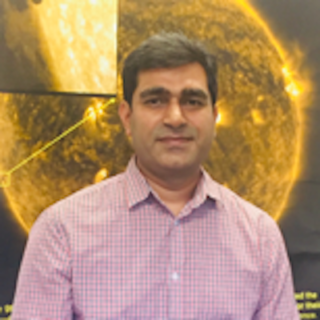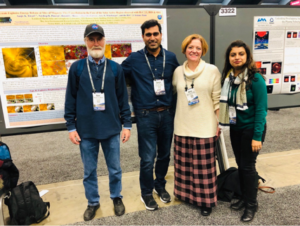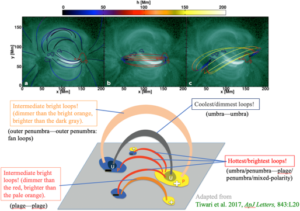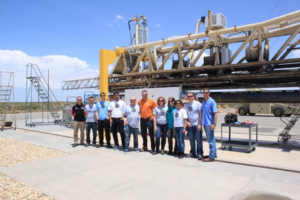Sanjiv K. Tiwari (he/him)
Senior Research Scientist [A member of Hinode/SOT and IRIS teams at Lockheed Martin Solar and Astrophysics Laboratory]

I work in solar physics, trying to understand the Sun.
Current research
Questions
What drives solar explosions (from fine-scales to large-scales) and heating on the Sun? What are fine-scale structures in sunspots, and how do they form and evolve? Can we predict the severity of space weather by assessing magnetic non-potentiality of solar active regions using photospheric vector magnetograms?
Approach
I analyze high-resolution extreme ultraviolet (EUV) spectra and images (at both spatial and temporal scales) as well as magnetograms from the following instruments: IRIS, Hinode, SDO, Hi-C, Solar Orbiter, as well as upcoming missions such as DKIST, and Solar-C_EUVST. I am also currently using realistic MHD simulations (Bifrost) to understand fine-scale heating in emerging flux regions and quiet Sun regions.
Innovations & Discoveries
I clarified the structure of sunspot penumbral filaments (Tiwari et al. 2013, A&A). In another work, I showed that the heating of a coronal loop depends on the magnetic field strength and freedom of convection at “both” feet of the loop (the hottest ones in an active region connect sunspot umbra/penumbra to penumbra, unipolar, or mixed-polarity plage). Umbra-to-umbra loops have the strongest magnetic field, but they are the dimmest loops. Thus, the belief that the heating is directly proportional to the field strength is not correct – convection plays an equally important role (Tiwari et al. 2017, ApJ Letters).
Lastly, I found that a significant amount of heating in active region cores (Tiwari et. al. 2019, ApJ) or in emerging flux regions (Tiwari et al. 2022, ApJ) occurs in the form of fine-scale dots, tiny loops, or small surges/jets.
Technical Description
I have used magnetic field data from Hinode (Spectropolarimeter/SP) and inferred physical parameters using ME and depth-dependent inversions to study fine-scale structure of sunspots, and have used Hinode (Filtergraph/FG) data to investigate photospheric and chromospheric dynamics in sunspot penumbra. I have used UV spectra and slit-jaw images from the IRIS mission to investigate plasma flows, and twisting and physical properties (temperature, density) of small-scale jets, including penumbral jets, surges, and coronal jets. For coronal EUV images, I have used high-resolution data from SDO/AIA, Hi-C flights, and Solar Orbiter/EUI. Recently, I have also been analyzing BIFROST MHD simulations to understand fine-scale heating in emerging flux regions. I have used SDO/HMI vector magnetograms to show that the upper speed of a CME emanating from an active region can be predicted by calculating magnetic non-potentiality of the active region.
Publications
External Links
Current Projects

At AGU Fall Meeting 2019 in San Francisco. From left to right: Ron Moore, Sanjiv Tiwari, Amy Winebarger, and Navdeep Panesar.

Dependence of the heating in active-region coronal loops on the magnetic setting of their feet. Panels a, b, and c display an image of NOAA AR 12108 in AIA 94 Å channel on which different extrapolated non-linear force-free field lines are over-plotted. Panels b and c show that umbra-to-umbra loops are not visible in AIA 94 Å channel. The sketch in the lower panel depicts the dependence of the coronal brightness of active region coronal loops on the photospheric magnetic rooting of the loops: (i) The brightest and hottest coronal loops (in red) connect sunspot umbra or penumbra to opposite-polarity penumbra, unipolar plage or mixed-polarity plage. (ii) Plage-to-plage loops (in bright orange) of the same length never become as bright and hot as the loops in (i). (iii) Umbra-to-umbra loops (in dark gray) are the dimmest coronal loops -- thus, the scaling laws that directly relate the rate of heating with the field strength at the loop feet or in the loop body should be interpreted with caution. Please see the following paper for details: https://ui.adsabs.harvard.edu/abs/2017ApJ...843L..20T/abstract

With the Hi-C team during one of the Hi-C rocket launches in White Sands, NM, USA.
Education
Jun 2010: Ph.D. (Physics), Udaipur Solar Observatory/MLS University, Udaipur, India
(Recipient of Justice Oak Best PhD Thesis Award of the year 2010, by Astronomical Society of India)
Mar 2003: M.Sc. (Physics) (I div.), V. B. S. Purvanchal University, India
Aug 2000: B.Sc. (Physics, Maths) (I div.), V. B. S. Purvanchal University, India.
(Recipient of Justice Oak Best PhD Thesis Award of the year 2010, by Astronomical Society of India)
Mar 2003: M.Sc. (Physics) (I div.), V. B. S. Purvanchal University, India
Aug 2000: B.Sc. (Physics, Maths) (I div.), V. B. S. Purvanchal University, India.
Get in touch: tiwari (at) baeri.org // tiwari (at) lmsal.com
About Sanjiv
Where are you from, and what were you doing before BAERI?
I grew up in north India, and currently live in the Bay Area, CA. Before coming to BAERI I was a NASA Postdoctoral Program (NPP) Fellow at the NASA Marshall Space Flight Center, and a Research Scientist at the Center for Space Plasma and Aeronomic Research (CSPAR) at the University of Alabama in Huntsville. I continue to hold an Adjunct Graduate Faculty position at CSPAR, Space Science Division, at the University of Alabama in Huntsville.
What’s one job-related thing that you love talking about with other people?
About sunspot fine structures, and chromospheric/transition-region/coronal heating.
How about a non-job related thing?
Walking, Yoga, and watching TV.
We are a community of researchers, engineers,
explorers, writers, and more. Our shared belief
in the power of science inspires our work to
better understand our planet, and the universe.
explorers, writers, and more. Our shared belief
in the power of science inspires our work to
better understand our planet, and the universe.
